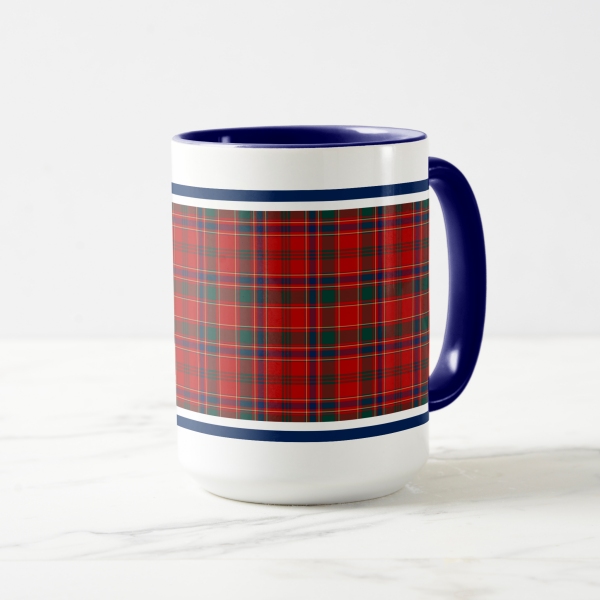
Motto: Dread God
Historic Seat: Foulis Castle
District: Ross-shire
Associated Surnames: Dingwall, Foulis, Keddie, Kiddie, MacCulloch, MacLullich, Vass, Wass
Associated Tartans:
Early Munro Genealogy and History:
(Excerpt from "The Scottish Clans and Their Tartans", James Grant, 1906)
The clan of Munro (like that of MacMillan) is supposed to descend from some of the ancient tribes of Moray, such as the Vacomagi.1 The most ancient genealogy makes them come from Ewen, son of Donald Dhu, and traces them up to Milan, the son of Neil. In Gaelic they are called the Clan Roich. Their possessions were on the north side of the Firth of Cromarty, and the title of their chief is and was Munro of Foulis. According to Burke, Hugh Monro, first designated of Foulis, died in 1126. George Munro of Foulis is said to have got a charter from the Earl of Sutherland in the reign of Alexander II (1214-49).
Robert Munro in 1309 got a charter from Robert I for lands in Strathspey and the lands of Cupermakcultis. The Munroes held their lands of, and were followers of, the ancient Earls of Ross.
In 1333, according to Sir Robert Gordon, John Munro, tutor of Foulis, when travelling home from Edinburgh to Ross with his servants, reposed for a night in a meadow near Strathardle, where the owner of the ground, in the dark, cut off their horses' tails. Summoning 350 of his best men, in revenge for this he ravaged Strathardle, slew many of the people, and carried off their cattle. In passing Moy, MacIntosh demanded a share of the latter, as it was customary when cattle were driven through a gentleman's land to give him what was called a Staoig Chreiche, or "Road Callop." Munro refused, so a fight between the clans ensued at Clach-na-harry. MacIntosh paid dear for his rapacity, as he and most of his men were slain; while many of the Munroes fell, and John Munro was left for dead, and would have died had he not been succoured by the Frasers. In this fight (which Shaw dates 1454, and Anderson 1378) the Munroes galled the MacIntoshes fearfully with their arrows.
In 1544 and 1550 two bonds of Kindness and Alliance were signed between Ross of Balnagowan and Robert Munro of Foulis, the former at Rosskeyne, and the latter at Balnagowan. Robert Munro of Foulis was slain at the battle of Pinkie2 in 1547.
Robert Munro, sixteenth of that Ilk, according to Burke; fifteenth according to the Roll of the Clans, who died without issue in 1587, was succeeded by his brother Hector, who married, firstly, a daughter of Hugh, Lord Fraser of Lovat, by whom he had two sons and a daughter; and second, Janet daughter of Andrew Munro of Milltown, but had no other issue. Hector Munro died in November 1603, and was succeeded by his son Sir Robert Munro, commonly called the Black Baron. He was Colonel of two Dutch regiments, one of a Horse, the other of Foot, under Gustavus Adolphus; in the Swedish army twenty-seven field-officers and eleven captains of the surname of Munro. Of these John Munro of Obstell, a Colonel of Scots, was slain on the banks of the Rhine; and Sir Hector Munro, Colonel of Dutch, died at Hamburg in 1635, "and was buried at Buxtehood in the old land on the Elve."
In 1632 the Munroes mustered 1000 strong at the funeral of Lord Lovat in Kirkhill; the Grants were 800; the MacKenzies, 900; the Rosses, 1000; and the Frasers, 1000, all in arms - a singular gathering.
The Black Baron, leaving no male issue (his daughter Margaret was married to MacKenzie of Skatwell), was succeeded by his brother Hector Munro, who was created a Baronet of Nova Scotia 7th June 1634, and married Mary, daughter of Hugh MacKay of Farre. He died in 1635, and was succeeded by his only son Sir Hector, who died unmarried in 1651, in his seventeenth year, when the title devolved upon his cousin Robert, who became the third Baronet, and married, Jean, eldest daughter of Sir Hector, the first Baronet. Sir Robert, who had seven sons, died in 1668, and was succeeded by his eldest, Sir John, who married a daughter of MacKenzie of Coul, and dying in 1696, was succeeded by his son Sir Robert, appointed High Sheriff of Ross under the Great Seal in 1725. Dying four years after, he was succeeded by his eldest son Sir Robert, sixth Baronet, a gallant officer who fell at Falkirk at the head of the 37th Regiment, fighting against James VIII. His son, Sir Harry, won a high reputation as a scholar, and died in Edinburgh in 1781.
Among the distinguished members of this clan we cannot forget those who shed such lustre on the School of Anatomy at Edinburgh; Alexander Munro, primus, of the family of Milltown, whose grandfather fought at Worcester;3 Alexander Munro, secundus, born in 1733; and his son Alexander Munro tertius.
Nor can we forget the gallant Sir Hector Munro, K.C.B.,4 Colonel of the Black Watch, so distinguished for service in India, and who died in Navar, in Ross-shire, in 1805.
There was another distinguished soldier of the clan, Major-General Sir Thomas Munro, born at Glasgow in 1761. He served in the Mysore war against Ilyder Ali and the fall of Seringapatam. In 1820 he was Governor of Madras, and was created a Baronet 30th June 1825. He was succeeded by his son, the present Sir Thomas Munro, Bart., of Lindertis.
(End excerpt)
Next page: Clan Murray
Footnotes:
1 Vacomagi: The Vacomagi were a people of ancient Britain, known only from a single mention of them by the geographer Ptolemy c. 150. From his general description and the approximate locations of their neighbors, their territory was the region of Strathspey. Read more about Historical Celtic People at Wikipedia.
2 The Battle of Pinkie Cleugh (1547): The Battle of Pinkie Cleugh was fought on 10 September 1547 on the banks of the River Esk near Musselburgh, Scotland. It was the last pitched battle between Scottish and English armies, and was a defeat for Scotland. Read more about the Battle of Pinkie Cleugh at Wikipedia.
3 The Battle of Worcester (1651): The Battle of Worcester was fought on 3 September 1651 at Worcester, England and was the final battle of the English Civil War. Cromwell's army defeated King Charles II's army, of whom the vast majority were Scottish. Read more about the Battle of Worcester at Wikipedia.
4 K.C.B.: Knight Commander, The Most Honourable Order of the Bath. Read about the Order of the Bath at Wikipedia.

Distribution of Scottish clans and families
View larger map at Wikimedia Commons

Browse the Clan Munro Tartan Collection with home decor, personal accessories, crafting, paper products, and more.

Browse the Ross-shire District Tartan Collection with clothing, home decor, accessories, electronics cases, and more.

Clan Munro Postcard: Digitally cleaned and enhanced vintage illustration with tartan border.